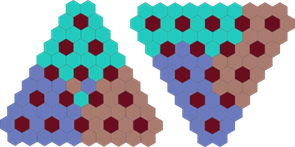The game setup can be chosen at the beginning:
A. Stones have three different colors. Each player chooses a color to play with. Then, players receive half of each opponent's stones if three players are participating. If only two players are playing, they receive all of their opponent's stones. Players then take turns placing one opponent's stone at a time until the entire playing field is filled. Finally, if only two players are playing, any remaining stones that don't belong to either player can optionally be placed on the board, or the spaces can be left empty.
B. This is the same as variant A, except that each player uses their own stones. In this variant, a player can win without making any ZOP moves (assuming ZOP is a specific game move, the definition of which is not provided here).
C. Players arrange their stones according to one of the provided diagrams (diagrams not included in the provided text).

A player makes a ZOP move. Then, the next player in a clockwise direction takes their turn. The winner is the player who connects all three sides with their stones. If three players are playing, the remaining two players can continue the game under the same conditions.
Markers
Players can use markers to indicate the rotators (assuming 'rotators' refers to specific game elements; the exact meaning isn't provided) they last played with. Players cannot then play with rotators that have a marker on them.
Players choose at the beginning how they will work with markers:
- There is only one marker for all players, and each player places it on the rotator they last played with after their turn. One marker thus prevents them from playing with that rotator.
- Each player has their own marker. They remove it before their turn, make their move, and then place it on the rotator they last played with. This blocks two markers for a player in their turn if three players are playing, or one marker if two players are playing.
- Each player has their own marker, and they leave it in its current position. They make their move and then move their marker to the rotator they last played with. This blocks three markers for a player in their turn if three players are playing, or two markers if two players are playing.
ZOP Moves
In the basic variant, each player makes only one ZOP move. However, they can agree to make multiple ZOP moves each.
To facilitate the game's end, there can be a rule that a player who believes they are close to winning can declare their final moves (typically three), after which they must connect all three sides. Otherwise, they lose. At least five ZOP moves must have been played before this can be done.